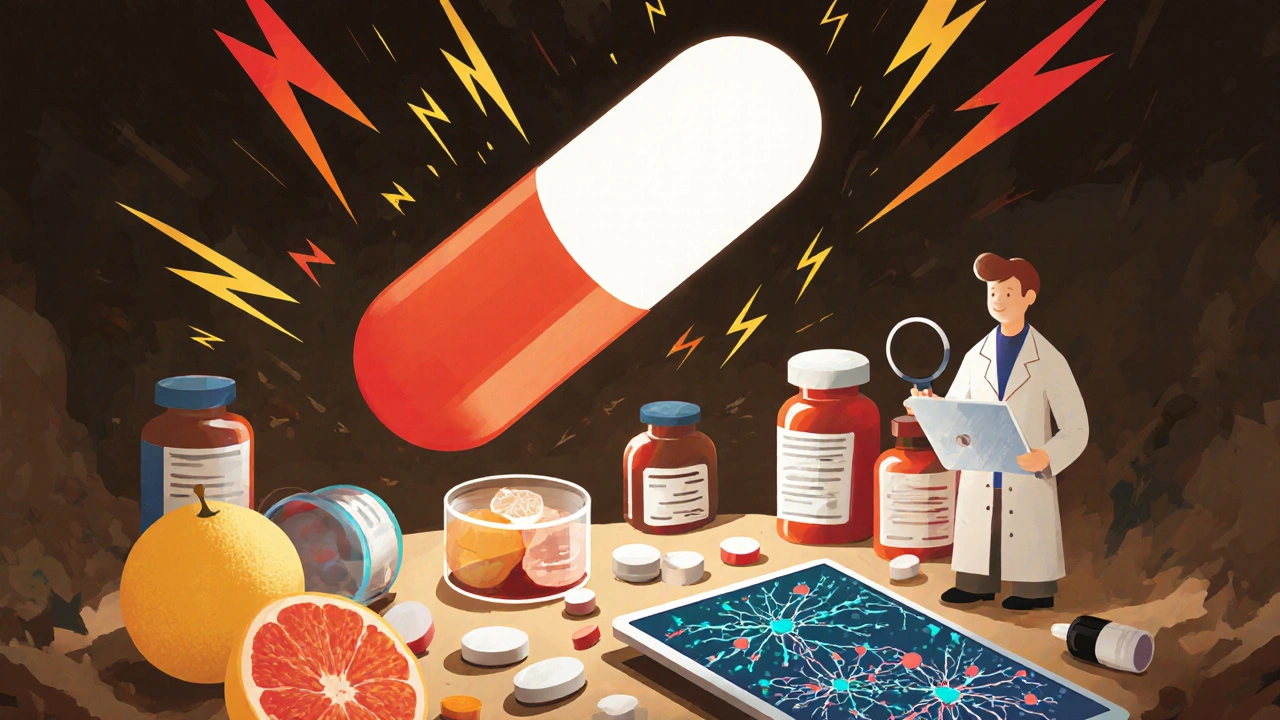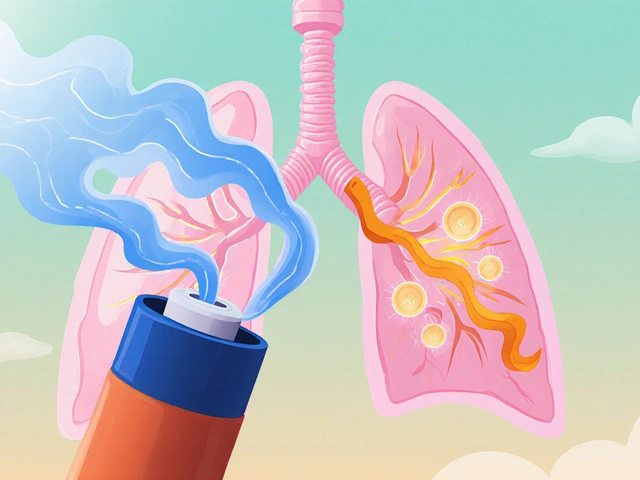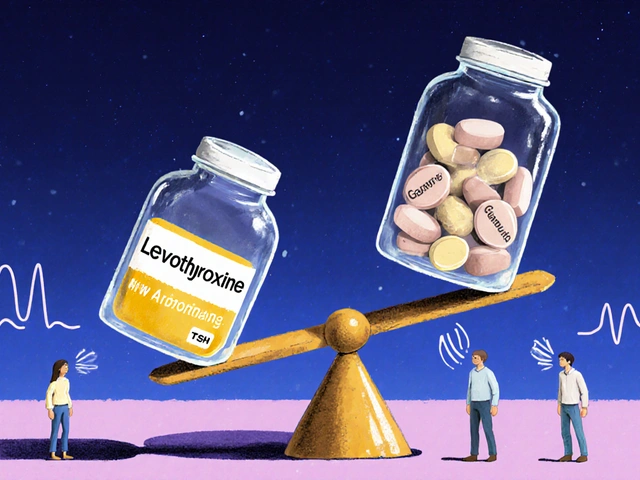Every year, tens of thousands of people end up in the hospital because of unexpected reactions between their medications. Some of these reactions happen because someone took a new pill without checking if it would clash with what they were already using. A drug interaction checker can help prevent this-but only if you use it right.
What a Drug Interaction Checker Actually Does
A drug interaction checker is a digital tool that scans the medications, supplements, and even foods you’re taking to find dangerous combinations. It doesn’t guess. It compares your list against a database of known interactions-like how grapefruit can make blood pressure meds too strong, or how St. John’s wort can cancel out birth control. These tools look at three types of risks:- Drug-drug interactions: When two pills affect each other’s absorption, metabolism, or effect. For example, taking ibuprofen with warfarin raises bleeding risk.
- Drug-food/drink interactions: Alcohol with antibiotics, dairy with thyroid meds, or grapefruit with statins.
- Drug-condition interactions: A medication that’s risky because of your health issue-like decongestants for someone with high blood pressure.
Some tools, like the University of Liverpool’s COVID-19 Drug Interactions Checker, go even deeper. They track new evidence weekly and flag interactions specific to treatments like Paxlovid. That kind of precision matters when lives are on the line.
Not All Checkers Are Created Equal
There are dozens of free apps and websites that say they check drug interactions. But not all are reliable. A 2016 NIH study tested five major tools and found big differences.| Tool | Sensitivity (Detects Real Risks) | Specificity (Avoids False Alerts) | Comprehensiveness |
|---|---|---|---|
| Lexi-Interact | 77% | Not rated | 370/534 |
| Micromedex | Not rated | 78% | 330/534 |
| iFacts | Not rated | Not rated | 134/134 (perfect) |
| Epocrates | 60.3% | Not rated | Lower than others |
| Medscape | 49% | Not rated | Lower than others |
| WebMD / Drugs.com (consumer) | ~60% | Varies | Good for OTC and supplements |
Here’s what that means in real terms:
- Lexi-Interact catches the most real risks-but it also throws up a lot of false alarms. It’s great for pharmacists who need to be thorough.
- Micromedex is better at ignoring noise. Fewer alerts, but it might miss something rare.
- iFacts has the most complete database. If it says there’s an interaction, it’s almost certainly there.
- Epocrates and Medscape are less accurate. Don’t rely on them alone, especially for high-risk meds.
- WebMD and Drugs.com are fine for casual checks, especially for supplements. But they miss about 40% of serious interactions.
How to Use a Checker Without Getting a False Sense of Security
Using a drug interaction checker isn’t like checking the weather. It’s not a final answer. It’s a starting point. Here’s how to use it right:- Make a full list. Write down every pill, patch, vitamin, herb, and even over-the-counter painkiller. Don’t forget your CBD oil or melatonin. About 23% of dangerous interactions involve supplements.
- Use the right tool. If you’re a patient, use Drugs.com or WebMD. If you’re a healthcare provider, use Lexi-Interact or Micromedex. For COVID-19 meds, go straight to the University of Liverpool’s checker.
- Look for color codes. Tools like the University of Liverpool’s use red, orange, yellow, and green to show severity. Red means don’t take together. Orange means monitor closely. Yellow means watch for symptoms.
- Focus on high-severity flags. Only 5-10% of flagged interactions are truly dangerous. Ignore the noise. If it says “possible mild interaction,” don’t panic. But if it says “risk of serotonin syndrome” or “life-threatening arrhythmia,” stop and call your pharmacist.
- Double-check with a professional. Even the best tool misses things. The FDA says no checker replaces a pharmacist’s review for people taking five or more medications.
Why You Can’t Trust These Tools Fully
No drug interaction checker is perfect. Here’s why:- New drugs aren’t fully tested. When a new medication hits the market, it’s tested against a few common drugs. But it might interact with something no one’s thought to test yet.
- Supplements are a blind spot. Many tools have incomplete data on herbs, vitamins, and CBD. One patient relied on a free checker that missed a deadly interaction between sertraline and linezolid. Result? Serotonin syndrome. She ended up in intensive care.
- False alerts cause alert fatigue. In hospitals, pharmacists dismiss up to 45% of alerts because they’re not clinically relevant. That means if you see too many warnings, you might start ignoring them-even the important ones.
- They don’t know your full story. A checker doesn’t know if you’re 78 and have kidney disease, or if you drink three glasses of wine every night. That context changes everything.
Dr. David Flockhart, a leading clinical pharmacologist, put it simply: “DDI checkers are essential but imperfect tools that must be paired with clinical judgment.”
What the Experts Say About Best Practices
The American Society of Health-System Pharmacists (ASHP) recommends using at least two independent checkers for high-risk patients. Why? Because studies show up to 20% of interactions are flagged by one tool but missed by another. Dr. Paul Offit, a vaccine expert, praised the University of Liverpool’s tool during a CDC webinar, calling it “the most comprehensive resource for COVID-19 drug interactions.” That tool updates every week based on new research-a rare level of responsiveness. But there’s a warning too. Dr. Adam Gaffney from Harvard says overreliance on these tools can lead to “therapeutic inertia”-where doctors avoid prescribing needed meds just because a checker flagged a low-risk interaction. That’s just as dangerous as ignoring a real risk.
What to Do If You’re Taking Five or More Medications
If you’re on five or more drugs, you’re in the high-risk group. According to CDC data, adults over 65 take an average of 4.8 prescriptions. That’s a recipe for hidden clashes. Here’s your action plan:- Bring your complete list to every doctor and pharmacist visit.
- Ask: “Is there anything here that could interact badly?”
- Use a trusted checker (Lexi-Interact or Micromedex if you can access them).
- Ask your pharmacist to run a double-check. Most will do it for free.
- Don’t assume “natural” means safe. Turmeric, garlic, and ginkgo can thin your blood just like aspirin.
What’s Next for Drug Interaction Tools
The future is moving fast. In 2024, Epic Systems rolled out a new feature called “InteractionGuard” that doesn’t just check what you’re taking-it looks at when you take it. Timing matters. Taking a statin at night instead of morning can reduce muscle damage risk. No current checker does that. AI is also being trained to predict interactions from real-world patient data, not just lab studies. Early results show an 18.3% improvement in detecting hidden risks. But the core truth won’t change: tools are helpers, not replacements. The best drug interaction checker in the world can’t replace a conversation with your pharmacist.Can I rely on free drug interaction checkers like WebMD or Drugs.com?
You can use them for quick checks, especially for over-the-counter meds and supplements. But they miss about 40% of serious interactions. Don’t use them as your only safety net. If you’re on multiple prescriptions, always confirm with a pharmacist.
Why do some tools flag interactions that seem harmless?
Many tools are designed to be overly cautious to avoid missing anything. A “possible interaction” might mean the drugs are metabolized by the same liver enzyme, but only at very high doses. That’s not always dangerous. The key is to look for severity levels-red and orange flags need action; yellow and green usually don’t.
Do drug interaction checkers work for herbal supplements?
Some do, but not well. Tools like Drugs.com and WebMD cover common supplements like St. John’s wort, garlic, and ginkgo. But many others-especially newer or less popular ones-are missing. Epocrates has particularly poor supplement coverage. Always assume herbal products can interact, and tell your pharmacist exactly what you’re taking.
What’s the best drug interaction checker for someone on multiple prescriptions?
For patients with complex regimens, Lexi-Interact and Micromedex are the gold standards used in hospitals. They’re not always free, but many pharmacies and clinics give access to patients. If you can’t get them, use Drugs.com and then ask your pharmacist to run a second check using a professional tool.
Can I use a drug interaction checker if I’m taking new medications?
Yes-but be extra careful. New drugs haven’t been tested against every possible combination. A checker might not flag a risk simply because the data doesn’t exist yet. Always ask your doctor or pharmacist: “Has this been tested with my other meds?”
Do I need to check interactions every time I get a new prescription?
Absolutely. Even if you’ve been on the same meds for years, a new drug can change everything. A 2023 study found that 60% of dangerous interactions happen after a new prescription is added. Always check before you start any new pill-even if it’s just a short course.





satya pradeep
November 18, 2025 AT 18:06Bro, I used WebMD to check my statin and fish oil combo and it said 'mild interaction' - so I kept taking it. Two weeks later I was bleeding out of my gums. Turns out warfarin was in my system from a past heart thing I forgot about. Don't trust free tools. Ever. My pharmacist laughed when I showed her the screenshot.
Prem Hungry
November 20, 2025 AT 08:20Respected sir, I must express my heartfelt gratitude for this comprehensive guide. As a junior pharmacist in rural India, access to professional tools like Lexi-Interact is rare. I now cross-check every patient's regimen with Drugs.com and then verify with my senior. Your emphasis on double-checking saved a patient from serotonin syndrome last month. Thank you.
Leslie Douglas-Churchwell
November 20, 2025 AT 10:42OMG 🤯 THIS IS WHY THE PHARMA BILLIONAIRES WANT YOU TO TRUST APPS. They know if you use WebMD, you'll miss the *real* interaction - the one between your meds and the glyphosate in your oat milk. The FDA doesn't test for *that*. And don't get me started on how 87% of 'natural' supplements are laced with unlisted SSRIs. I read a paper in The Lancet that said...
Also, your pharmacist? Probably on their payroll. 💉🧪
shubham seth
November 21, 2025 AT 19:06Let’s be real - these tools are glorified bingo cards for pharmacists. Lexi-Interact throws up more red flags than a Marxist rally. I once saw it flag ibuprofen + caffeine as 'severe interaction' because both are metabolized by CYP1A2. Bro, I drink coffee with my Advil every damn morning. If that’s a life-threatening combo, then my entire existence is a clinical trial gone wrong.
Meanwhile, iFacts? That thing’s got more data than the NSA. If it says 'no interaction,' you can probably sleep easy. But if it’s silent? That’s the real red flag. Silence = untested = dangerous.
Kathryn Ware
November 22, 2025 AT 12:08This is so important!! 🙌 I’m a nurse and I literally hand out printed lists to my elderly patients - ‘Write EVERYTHING down, even the gummy vitamins your grandkid gave you.’ One lady was taking melatonin, turmeric, and a blood thinner - no one asked her about the gummies. She almost bled out. Now I make them show me their pill organizer. And yes, I use Drugs.com as a first pass, but I always call the pharmacy to run it through Micromedex. The difference? Night and day. Also - if you’re on 5+ meds, please, please, PLEASE schedule a med review. It’s free at most pharmacies. You’re worth it 💖
kora ortiz
November 23, 2025 AT 16:43Jeremy Hernandez
November 25, 2025 AT 03:05Wow another one of these 'trust your pharmacist' sob stories. Newsflash - most pharmacists are just glorified cashiers who read off a script. I’ve seen them miss interactions that were staring them in the face. And don’t even get me started on Epic’s InteractionGuard - it’s just a fancy algorithm trained on biased data. Real solution? Stop taking so many damn pills. Your body isn’t a chemical factory.
Tarryne Rolle
November 26, 2025 AT 07:35But what if the tool is wrong? And what if the pharmacist is wrong? And what if the database is built on capitalist medical research funded by Big Pharma? We’re not just checking drug interactions - we’re negotiating a relationship with institutional authority. The checker is not a tool. It’s a mirror. And the reflection? It’s the illusion of control. You think you’re safe because a screen says so. But safety is a myth. The body is chaos. The algorithm is arrogance.
Kyle Swatt
November 26, 2025 AT 16:10Man I used to think these tools were useless until I got prescribed a new antidepressant and threw in some CBD oil because ‘it’s natural.’ The checker didn’t flag it. My doc didn’t ask. Two days later I was hallucinating my cat was whispering quantum physics.
Turns out CBD inhibits CYP3A4 - same enzyme that metabolizes my med. The tool missed it because it’s not in the database. But the *feeling*? That was real. So now I ask myself: if a tool doesn’t know it, does it still matter? Yeah. It matters. Because your body doesn’t care about databases. It only cares about what you put in it.
Deb McLachlin
November 28, 2025 AT 08:49Thank you for this meticulously researched piece. I am a clinical pharmacist in Toronto and I can confirm that the data presented aligns with our institutional protocols. We routinely utilize Lexi-Interact and Micromedex in tandem, as recommended. I would add one further consideration: patient literacy. Many individuals, particularly those over 70, cannot interpret color-coded alerts. We now print severity levels in plain language - 'Stop immediately,' 'Call your doctor,' 'Monitor for dizziness.' Technology must serve the user, not the other way around.